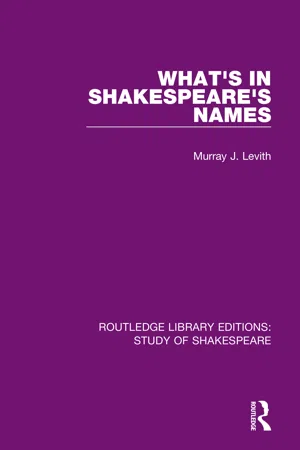
- 148 pages
- English
- ePUB (mobile friendly)
- Available on iOS & Android
What's in Shakespeare's Names
About This Book
'What's in a name? That which we call a rose/By any other name would smell as sweet.' So says Juliet in the balcony scene from Romeo and Juliet but, originally published in 1978, Murray Levith shows just how wrong Juliet was.
Shakespeare was extremely careful in his selection of names. Not only the obvious Hotspur or the descriptive Bottom or Snout, but most names in Shakespeare's thirty-seven plays had a more than superficial significance. Beginning with what has been written previously, Levith illustrates how Shakespeare used names – not only those he invented in the later comedies, but those names bequeathed to him by history, myth, classical literature, or the Bible.
Levith moves from the histories through the tragedies to the comedies, listing each significant name play by play, giving the allusions, references, and suggestions that show how each name enriches interpretations of action, character, and tone. Dr. Levith examines Shakespeare's own name, and speculates upon the playwright's identification with his characters and the often whimsical naming games he played or that were played upon him.
A separate alphabetical index is provided to facilitate the location of individual names and, in addition, cross references to plays are given so that each name can be considered in the context of all the plays in which it appears.
Frequently asked questions
Information
1 Juliet’s Question
That which we call a roseBy any other word [Quarto 1 has “name”] would smell assweet;So Romeo would, were he not Romeo call’d,Retain that dear perfection which he owesWithout that title.
Table of contents
- Cover
- Half Title
- Title Page
- Copyright Page
- Original Title Page
- Fm-chapter
- Fm-chapter1
- Original Copyright Page
- Dedication Page
- Table of Contents
- Preface
- Acknowledgments
- Fm-chapter2
- Epigraph
- 1. Juliet’s Question
- 2. Histories
- 3. Tragedies
- 4. The Comedies and Romances
- 5. Shakespeare’s Name
- Notes
- Index